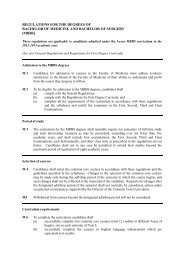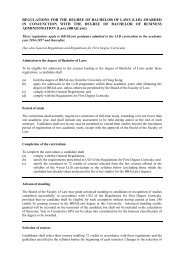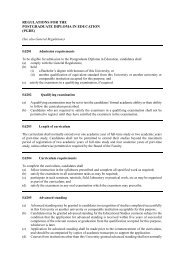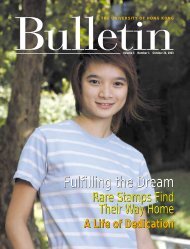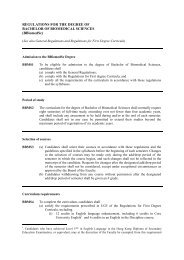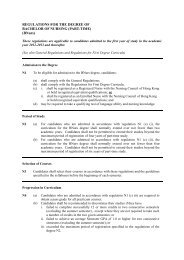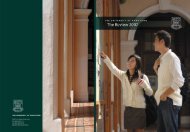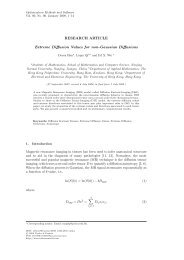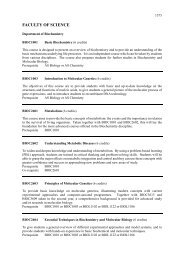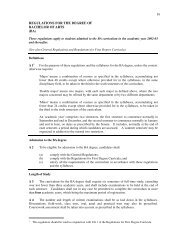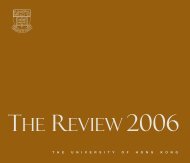Bachelor of Arts (BA) - The University of Hong Kong
Bachelor of Arts (BA) - The University of Hong Kong
Bachelor of Arts (BA) - The University of Hong Kong
You also want an ePaper? Increase the reach of your titles
YUMPU automatically turns print PDFs into web optimized ePapers that Google loves.
219JAPN2013.Women in Japan (6 credits)(This course is also <strong>of</strong>fered to second and third year non-<strong>BA</strong> students for inter-Faculty broadeningpurposes.)This interdisciplinary content course - taught by lectures and tutorials - focuses on the issue <strong>of</strong> gender inJapan. It will start with a brief overview <strong>of</strong> women's position in Japan in various historical periods toprovide a background for dealing with women's roles and positions in contemporary Japanese society.<strong>The</strong> course will focus on how girls are socialized and educated, on women's role in the family, the workplace, and in public life. Throughout the course the complementary roles <strong>of</strong> men and women will beexamined, so that a picture <strong>of</strong> the roles and positions <strong>of</strong> men in Japan will also emerge.Assessment: 100% coursework (a research project, presentations, participation in group discussions).JAPN2014.China and Japan (6 credits)This interdisciplinary content course will examine the history <strong>of</strong> Chinese-Japanese relations in thecontext <strong>of</strong> East Asian world order up to the early twentieth century. Attention will be paid to the factthat the transfer <strong>of</strong> Chinese culture from China to Japan throughout history has been as much a politicalprocess as a cultural one both for China and Japan. <strong>The</strong> reverse flow <strong>of</strong> 'acquired' Western culture fromMeiji Japan to China in the early twentieth century will also be examined in some detail in order toprovide a comparative perspective on the modernization <strong>of</strong> the two countries. Students must be able toread Chinese. A knowledge <strong>of</strong> Japanese will be helpful.Assessment: 100% coursework (presentations and essays).JAPN2015.Japanese enterprise groupings (6 credits)(This course is also <strong>of</strong>fered to second and third year non-<strong>BA</strong> students for inter-Faculty broadeningpurposes.)This interdisciplinary content course - taught by lectures and tutorials - concentrates on the study <strong>of</strong>Japanese enterprise groupings. It will start with three major theoretical perspectives on economicorganizations - structural, strategic, and institutional - to enable students to theoretically understandJapanese enterprise groupings. <strong>The</strong> histories <strong>of</strong> different enterprise groupings, their operation, and thefunction these groupings serve will then be examined. As such it will focus on such topics as the specialroles <strong>of</strong> main banks, general trading firms, insurance companies, core member corporations <strong>of</strong> thegroupings, and the so-called preferential trading between core large corporations and their peripheralcompanies. Finally, the discussion <strong>of</strong> these topics will be placed in the context <strong>of</strong> Japanese andAmerican trade conflicts so that students can have a general understanding <strong>of</strong> the conflicts.Assessment: 50% coursework, 50% examination.Examination: A two-hour written examination at the end <strong>of</strong> the second semester.JAPN2016.Comparative linguistics: Cantonese and Japanese IComparative phonology (6 credits)(This course is also <strong>of</strong>fered to second and third year non-<strong>BA</strong> students for inter-Faculty broadeningpurposes.)This interdisciplinary content course will detail the phonological components <strong>of</strong> Japanese andCantonese through extensive reading <strong>of</strong> current theories and a contrastive analysis. Besides construingboth common and specific traits <strong>of</strong> the sound system <strong>of</strong> human languages, the course will help studentsfamiliarize themselves with the most common sets <strong>of</strong> transcription used in language studies whichinclude the most important one, the International Phonetic Alphabets (IPA).Assessment: 100% coursework (a series <strong>of</strong> transcription tests and a final project on comparativestudies).Prerequisite: Japanese language I, Japanese language I(a) or Certificate Japanese Courses.



